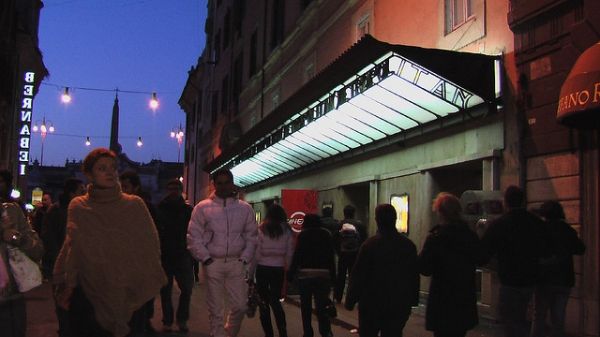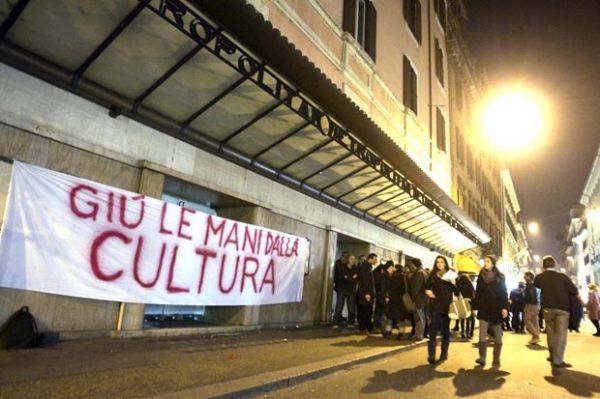Perhaps the future of original language films in Rome rests between the projector and those who place passion above profit
As a year of swingeing cuts to Italy’s culture and heritage budgets drew to a close, Rome waved goodbye to a bastion of English-language films in December 2010. Situated at the Piazza del Popolo end of Via del Corso the Metropolitan cinema began in 1911 as the American Film Theatre, changing its name to the Metropolitan in 1948. Famous for its screening of original language films it was beloved of the city’s foreign community.
When a rumour was confirmed that the cinema’s lease was coming to an end and that it faced closure, the news was met with internet campaigns and protests outside. Although over 8,000 signatures were delivered to the offices of former city councillor for culture Umberto Croppi, it was to no avail. Just shy of its 100th anniversary, the iconic cinema’s film projectors were switched off for the last time.
Owners of the Metropolitan building, Fininvest sold the prime-location property for a reported figure of €30million to a clothing company affiliated to the Benetton Group. The Metropolitan now joins a list of former cinemas in the centre of Rome such as the Majestic and Capranica, and the Pasquino in Trastevere, while multi-sala venues like Warner Village in Piazza Repubblica and Vis Pathé in the Pigneto district of east Rome have been taken over by cinema chains The Space and UCI respectively.
While it is true to say that lovers of English-language films lost a major outlet in Rome overnight, there is hope on the horizon – across the river in Trastevere to be exact. After hearing about the Metropolitan’s imminent closure, long-term Rome resident Don Carroll took executive action and paid a visit to Armando Leone, director of the Filmstudio, Rome’s premier venue for the promotion of independent, art house, historic and experimental films. Leone was immediately receptive to Carroll’s suggestion of establishing a programme of English-language films at the Filmstudio. Although cinemas such as Nuovo Olimpia, Greenwich and Nuovo Sacher all screen original language films, New York native Carroll, who has lived in Rome since 1984, believes that “the city has never had a good working model in the sense of a cinema responding to its English-speaking community.”
With this in mind he approached people he believed would bring diverging perspectives to oversee the project with the Filmstudio: Carolina Campaglia, Roy Doliner, Louise Vinciguerra, Michael Fitzpatrick, Romolo Tassone and Rachel Donadio. Thus was born the Silver Screen in Rome, a voluntary group of artistic directors, all with backgrounds in journalism, theatre and cinema.
To gauge the public’s enthusiasm, as well as seeking its advice on programming, the group developed an online questionnaire. Carroll describes the response as “overwhelming” with 1,140 replies to date. These opinions and suggestions were passed to Leone who is keen to point out that feedback is imperative for the Filmstudio to provide the best possible service. He says “After our initial meeting I thought that we could screen original version films just two nights a week but then I decided to arrange a fixed time for every day of the week. We’re going to start on an experimental basis and will be attentive to every suggestion from our foreign friends living in Rome.”
Launched on 10 March, the cinema screens films in their original language with or without subtitles every evening at 19.30 and 21.30. While these sessions are reserved primarily for recent productions, the Filmstudio will also show independent films of note. In addition, rarely-screened classics can be viewed on Tuesdays at 21.30 and Fridays at 17.00. Situated on Via degli Orti d’Alibert next door to the Lorcan O’Neill gallery and a stone’s throw from John Cabot University, it is well-placed to make the most of a captive English-speaking audience.
In the heart of Pigneto there is another unlikely tale of cinematic revival. The 40-seater Grauco film club on Via Perugia, which for 35 years screened classic, cult and original language movies, suffered the same financial fate as many film clubs across the city and closed in June 2010. But while the story of its closure was sad, the story of its rebirth is an inspiration.
Four devotees of Grauco quite literally took matters into their own hands. Without receiving any external funding, they set about refurbishing the club, improvising as carpenters, plumbers, electricians, and later as accountants and press officers. By the time the project was nearing completion, some 60 people were involved. It opened on 10 February, reincarnated as Cinema Kino.
Kino’s head of programming Massimo Galimberti says “We’d like Kino to become a permanent festival, screening all those quality films seen at festivals around the world but which are rarely given a look-in here in Italy.” The programming will include documentaries, premieres and will feature the many Italian and foreign films not widely distributed in Italian cinemas.
At a time when the future of the city’s famous Cinecittà film studios is in doubt and funding for the state-run film archive Cinecittà Luce has been cut from €29m in 2004 to €7.5m this year, it is true to say that Italy’s film sector is not in a good place. However, out of the ashes of the Metropolitan, it appears that Rome might be witnessing something of a cinematic revolution. Together with the growing emergence of small, quality foreign film festivals in the capital, such as the fourth IrishFilmFesta last November and the current Australian Film Week, perhaps the future of original language films in Rome rests between the projector and those who place passion above profit.
To borrow one of Casablanca’s greatest misquotations, “it could be the beginning of a beautiful friendship.”
Andy Devane
Filmstudio, Via degli Orti d’Alibert 1/c, www.filmstudioroma.com.
Cinema Kino, Via Perugia 34, www.ilkino.it.

























